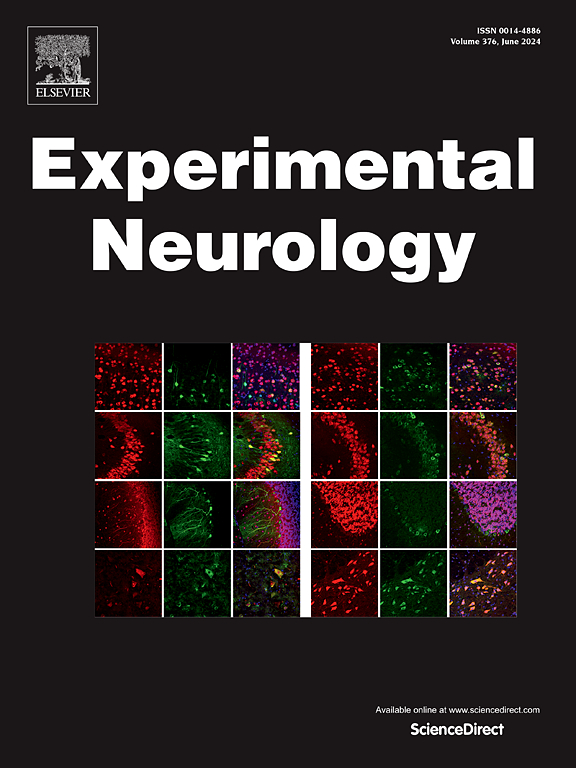Dynamic proteomic and phosphoproteomic analysis reveals key pathways and targets in the early stages of high-altitude traumatic brain injury
IF 4.6
2区 医学
Q1 NEUROSCIENCES
引用次数: 0
Abstract
Traumatic brain injury (TBI), particularly at high altitudes (HA-TBI), is a leading cause of mortality and disability, yet clear diagnostic and treatment protocols are lacking. This study explores the early pathophysiological changes occurring within 24 h following HA-TBI, with a focus on differentially expressed proteins (DEPs) and phosphorylated proteins (DEPPs). Using a low-pressure hypoxic chamber to simulate high-altitude conditions combined with a controllable cortical impact (CCI) model, we established a rat model of HA-TBI. Neurological function was evaluated using the modified Neurologic Severity Score (mNSS), while neuropathological and inflammatory responses following HA-TBI were evaluated through hematoxylin and eosin (HE) staining, immunofluorescence, Western blot (WB), and Enzyme-Linked Immunosorbent Assay (ELISA). In-depth proteomic and phosphoproteomic analyses were performed on the cerebral cortex at 6, 12, and 24 h post-injury. Bioinformatic analysis identified time-dependent DEPs, revealing dynamic changes in mRNA metabolism, ATP metabolism, and MAPK signaling during the early stages of HA-TBI. Common DEPs at 6, 12, and 24 h post-injury were linked to complement and coagulation cascades. Time-dependent DEPPs influenced synaptic structure and neurotransmission, with early changes in glutamatergic synapses being especially pronounced. Key pathways, including the complement and coagulation cascades and dopaminergic synapses, emerged as central to the injury response. Furthermore, proteins such as AHSG, APOA1, GRIN2B, phospho-GSK3β-S9, and CAMK2G were identified as critical regulators in these pathways. WB validated these findings, offering new insights into the mechanisms underlying HA-TBI and highlighting potential therapeutic targets for early intervention in high-altitude trauma.

动态蛋白质组学和磷酸化蛋白质组学分析揭示了高原创伤性脑损伤早期的关键通路和靶点。
创伤性脑损伤(TBI),特别是在高海拔地区(HA-TBI),是导致死亡和残疾的主要原因,但缺乏明确的诊断和治疗方案。本研究探讨HA-TBI后24小时内发生的早期病理生理变化,重点关注差异表达蛋白(DEPs)和磷酸化蛋白(DEPPs)。采用低压缺氧舱模拟高海拔环境,结合可控皮质冲击(CCI)模型,建立HA-TBI大鼠模型。采用改良的神经系统严重程度评分(mNSS)评估神经功能,通过苏木精和伊红(HE)染色、免疫荧光、免疫印迹(WB)和酶联免疫吸附试验(ELISA)评估HA-TBI后的神经病理和炎症反应。在损伤后6、12和24小时对大脑皮层进行深入的蛋白质组学和磷蛋白质组学分析。生物信息学分析确定了时间依赖性dep,揭示了HA-TBI早期mRNA代谢、ATP代谢和MAPK信号的动态变化。损伤后6、12和24小时常见的dep与补体和凝血级联反应有关。时间依赖性depp影响突触结构和神经传递,谷氨酸能突触的早期变化尤为明显。包括补体和凝血级联以及多巴胺能突触在内的关键通路是损伤反应的核心。此外,AHSG、APOA1、GRIN2B、phospho-GSK3β-S9和CAMK2G等蛋白被鉴定为这些通路中的关键调节因子。WB证实了这些发现,为HA-TBI的潜在机制提供了新的见解,并强调了高原创伤早期干预的潜在治疗靶点。
本文章由计算机程序翻译,如有差异,请以英文原文为准。
求助全文
约1分钟内获得全文
求助全文
来源期刊

Experimental Neurology
医学-神经科学
CiteScore
10.10
自引率
3.80%
发文量
258
审稿时长
42 days
期刊介绍:
Experimental Neurology, a Journal of Neuroscience Research, publishes original research in neuroscience with a particular emphasis on novel findings in neural development, regeneration, plasticity and transplantation. The journal has focused on research concerning basic mechanisms underlying neurological disorders.
文献相关原料
公司名称
产品信息
索莱宝
DAPI
 求助内容:
求助内容: 应助结果提醒方式:
应助结果提醒方式:


